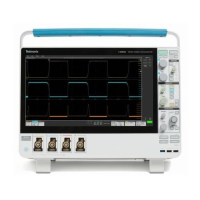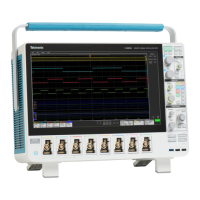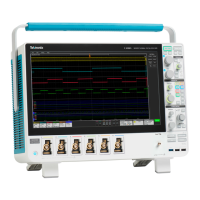Commands listed in alphabetical order
NPERIOD (Durat
ion N-Periods) is the time required to complete N cycles. A cycle
is the time between two adjacent (same direction) crossings of the Mid reference
level (RM). This measurement is made on each cycle in the record.
NPJ (non-periodic jitter) is the portion of the BUJ (bounded uncorrelated jitter)
that is random. BUJ excludes DDJ, DCD and RJ. This measurement is made
across the entire record.
NOVershoot (Negative Overshoot) is the d ifference between Minimum and
Base, divided by the Amplitude. This measurement can be made across the entire
record, or on each cycle in the record.
Negative Overshoot = (Base - Minimum) / Amplitude × 100%)
NWIdth (Negative Pulse Width) is the time the signal remains below the Mid
reference level (RM). This measurement is made on ea ch cycle in the record.
PDUTY (Positive Duty Cycle) is the ratio of the Positive Pulse Width to the Period.
This measurement is made on each cycle in the record.
Positive Duty Cycle = (Positive Width)/Period × 100%
PERIOD is the time required to c omplete a cycle. A cycle is the time between
two adjacent (same direction) cross i ngs of the Mid reference level (RM ). This
measurement is made on each cycle in the record.
PHASE is the ratio of the Skew between two sources to the Period of the first
source. This measurement is made on each cycle in the record.
PHASENOISE (Phase Noise) is the RMS magnitude of all integrated jitter falling
within a user specified offset range of the fundamental clock frequency. This
measurement is ma de across the entire record.
PJ (periodic jitter) is the peak-to-peak amp litude of the uncorrelated sinusoidal
components of the deterministic jitter. This measurement is made across the
entire record.
PK2Pk (Peak-to-peak) is the difference between Maximum and Minimum. This
measurement can be made across the entire record, or on each cycle in the rec o rd.
POVERSHOOT (Positive Overshoot) is the difference between Maximum a nd Top,
divided by the Amplitude. This measurement can b e made across the entire
record, or on each cycle in the record.
Positive Overshoot = (Maximum - Top) / Amplitude ×100%
PWIDTH (Positive Pulse Width) is the time the signal remains above the Mid
reference level (RM). This measurement is made on ea ch cycle in the record.
QFACTOR (Q-Factor) is the ratio of the vertical eye opening to RMS vertical noise
measured at a user spe cified location within the recovered unit interval. This
measurement is ma de across the entire record.
2-492 MSO54, MSO56, MSO58, MSO58LP Programmer

